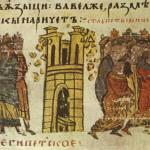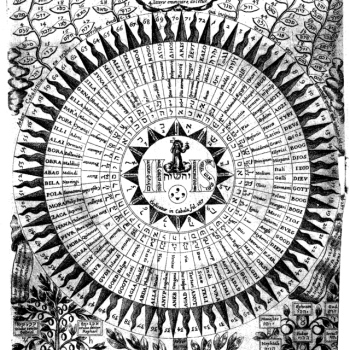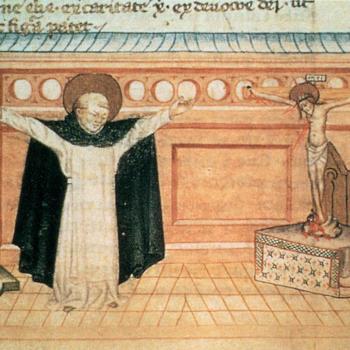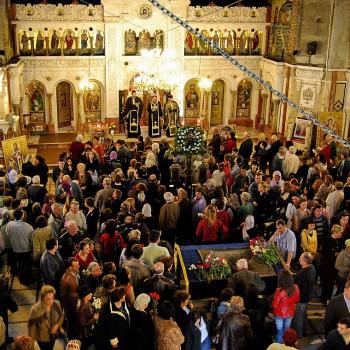 Dionysius turns to the figure of Moses as a key representative of the mystical tradition. Moses was one of the greatest theologians in history. He was able to use his engagement with God to teach and direct the people of Israel (and those who would read and study what he taught). Moses went to the place where God is all by himself, but he took with him those who, like him, were set apart and spiritually prepared to the spot where they could view where God was:
Dionysius turns to the figure of Moses as a key representative of the mystical tradition. Moses was one of the greatest theologians in history. He was able to use his engagement with God to teach and direct the people of Israel (and those who would read and study what he taught). Moses went to the place where God is all by himself, but he took with him those who, like him, were set apart and spiritually prepared to the spot where they could view where God was:
For even the divine Moses is himself strictly bidden to be first purified, and then to be separated from those who are not so, and after entire cleansing hears the many-voiced trumpets, and sees many lights, shedding pure and streaming rays; then he is separated from the multitude, and with the chosen priests goes first to the summit of the divine ascents, although even then he does not meet with Almighty God Himself, but views not Him (for He is viewless) but the place where He is.
Moses, it is said, saw the glory of God (cf. Ex. 33:18-20). He received transcendent truths which he handed over to the people of Israel in symbolic form. That is, as the book of Hebrews explained, Moses provided the people of Israel a “copy” and “shadow” of the truths which he learned from his experience with God:
Now the point in what we are saying is this: we have such a high priest, one who is seated at the right hand of the throne of the Majesty in heaven, a minister in the sanctuary and the true tent which is set up not by man but by the Lord. For every high priest is appointed to offer gifts and sacrifices; hence it is necessary for this priest also to have something to offer. Now if he were on earth, he would not be a priest at all, since there are priests who offer gifts according to the law. They serve a copy and shadow of the heavenly sanctuary; for when Moses was about to erect the tent, he was instructed by God, saying, “See that you make everything according to the pattern which was shown you on the mountain” (Heb. 8:1-5 RSV).
Moses climbed to the summit, experienced the truth and glory of God in a way which transcended his comprehension. He alone reached the top, the place where God was said to be, while those who he took with him only reached so far as to see the summit itself. They could not see God, but they could see where Moses went to engage God.
Filled with wonder and awe, Moses was able to share that experience in a form which pointed to the truth which lay beyond human comprehension. Those who study Moses and what he taught can learn from him the way to the truth; to receive it, they will have to follow Moses beyond the words used to discuss it and into the darkness of God themselves. This is why the prophets often contended against a literalistic approach to the law of Moses, such as when Jeremiah pointed out that the circumcision which was important was the circumcision of the heart (cf. Jer. 4:4), or when Isaiah said that the appointed feasts as the people of Israel had come to celebrate them in rote without following the spirit of the feast was something which God hated (cf. Isa. 1:14). The truth was proclaimed by Moses, but it was easy to misconstrue the truth by confusing the means of the message with the message itself. Its truth remains relevant, so long as we understand it properly. This is why Origen explained that the law of Moses is still with us and forever new in Christ so long as we follow it in the spirit, but it becomes old and dead if we look at it merely in regards the letter:
The law becomes an “Old Testament” only for those who want to understand it in a fleshly way; and for them it has necessarily become old and aged, because it cannot maintain its strength. But for us, who understand it and explain it spiritually and according to the gospel-meaning, it is always new. Indeed, both are “New Testaments” for us, not by age of time, but by the newness of understanding. [1]
Moses and Elijah, representing the law and the prophets, were seen next to Jesus on Mount Tabor for this very reason. The law of Moses was not repudiated by Jesus, for Jesus reaffirmed it: “Think not that I have come to abolish the law and the prophets; I have come not to abolish them but to fulfil them. For truly, I say to you, till heaven and earth pass away, not an iota, not a dot, will pass from the law until all is accomplished” (Matt. 5:17-18 RSV).
In this fashion, we have with Moses an example of how we should develop ourselves in order to prepare for our meeting with God. Before his journey, he first had to be first purified. Likewise, we must first practice self-denial; we need to detach ourselves from those things of the world which hinder our journey towards God. Everything which would distract us from our goal will make us impure and needs to be set aside, just as Moses had to set aside his status in order to lead the people of Israel out of Egypt. Then, to direct them further, and reveal the glory of God to all, Moses had to ascend to the summit of his spiritual potential. He had to be separated from those who are not so pure, not because he was to abandon them and their needs, but rather, because he needed to prepare himself to be receptive of the truth and grace of God so that he could receive them from God and then use them to effectively render service to others. This is why we, too, must be careful with those whom we associate; many who would hinder us from our spiritual ascent must, at least temporarily, be left behind. Those who cause undue strife in our lives, those who seek to limit us to their own potential instead of support us in our ascent to God, those who, if we followed them, would turn us away from where God should lead us, must be ignored insofar as they cause us such harm. On the other hand, we need others to journey with us, at least, insofar as their goal and ours work together. Thus, Moses was said to have taken with him others who, like him, were purified to some extent. Together, they were able to receive spiritual blessings, encountering various secondary manifestations of the divine as represented by the many-voiced trumpets, and many lights, shedding pure and streaming rays. But we must be careful and know these are not our goal. They can be a vehicle of grace and help us in our spiritual progression, but we must recognize their derivative nature and so not become attached to them. Many, when they first engage mystical experiences, will receive such spiritual blessings, see and encounter unusual sights and sounds, thinking this is their goal, that they have attained God and so not continue the journey towards God himself. This is why Dionysius, in recounting Moses’ ascent up the mountain of God, explained how Moses left all such things behind, taking only certain priests with him, to the summit where he does not meet with Almighty God Himself, but views not Him (for He is viewless) but the place where He is.
Moses climbed to the top of the mountain, pure of heart and mind, taking with him those who, like him, have attained such purity, only to find themselves still away from God, still unable to encounter and see God and his glory. They transcended what most will transcend in their lives. They went beyond the experience of derivative manifestations of the truth which reflect the transcendent God and come to the place where God is without such mediation, only to see him not. Knowing that he has gone beyond all kataphatic symbols and representations of God, Moses awaited God himself. He no longer had any expectation. He has taken the spiritual path God which God established and had come to its end. In transcending the secondary lights, but without the light of God, Moses found himself in a darkness without light, in a state of unknowing ready to transcend himself. Thus, in the scholia to our text, attributed to Anastasius the Librarian, we read:
We ought to think of the composition of the story he has told as follows: that Moses contemplated the place where God stood, and then he was freed from what we look at – that is, everything sensuous – and from what does the looking – that is, everything that reasons. Then he entered the darkness – that is, the unknowing which concerns God. Here he put aside all the aids or supports of knowledge, and came to the place of the one who is God over the universe, untouched, and unseen by any reception or aid of knowledge. [2]
What is said about Moses is what we must also expect; we will follow the path to God until we come to a darkness in which God is said to be present. Dionysius shows us through Moses the kind of spiritual progression found through mystical theology. We will first encounter great supernatural experiences but then find them vanishing as we continue our journey higher into the truth of God. We must not become confused or upset, but rather, realize that they are mediated lights of the truth which we must transcend if we want to attain the truth in God himself. We must close ourselves off from all externals, and then silence our thoughts, seeing and thinking nothing, going forward in a transcendent ignorance, so that we truly will be ready to engage God in the darkness where God is said to dwell.
[Image=Sunrise at Mt. Sinai; photograph by Henry Karlson]
[1] Origen, Homilies on Numbers. Trans. Thomas P. Scheck (Downers Grove, IL: IVP Academic, 2009), 39.
[2] A Thirteenth-Century Textbook of Mystical Theology at the University of Paris. trans. L Michael Harrington (Paris: Peeters, 2004), 67.
Stay in touch! Like A Little Bit of Nothing on Facebook













